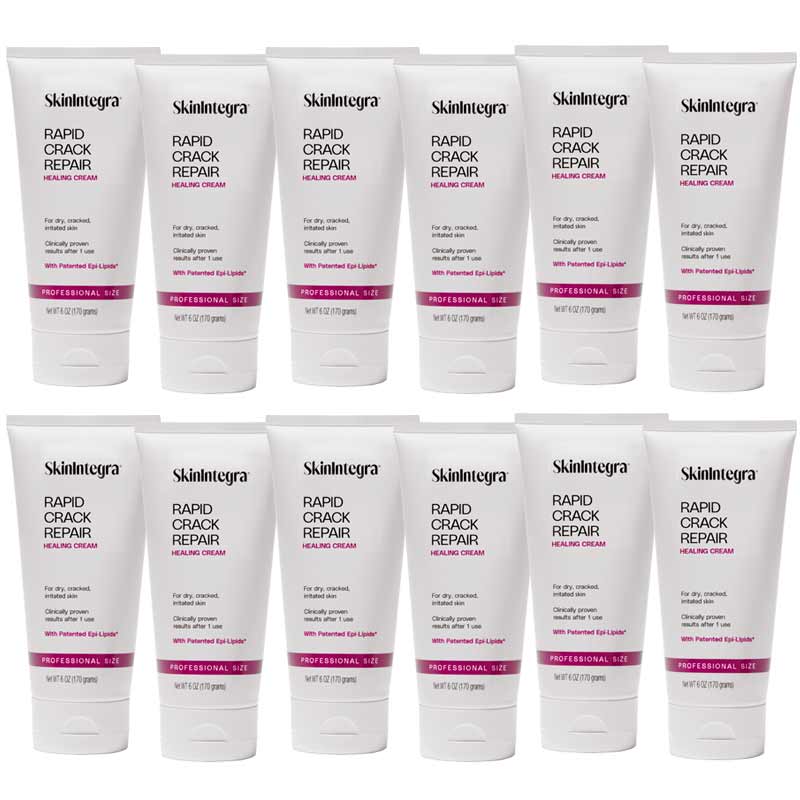Dry, cracked feet are one of the most common — and often overlooked — issues faced by people with diabetes. Left untreated, these seemingly minor concerns can lead to more serious complications, especially when neuropathy or poor circulation is involved. Understanding what causes dry diabetic feet and how to treat them effectively is essential to maintaining long-term foot health and avoiding preventable complications.
In this article, we explore the causes of cracked heels in diabetes, what a good foot care routine should include, and the science behind skin barrier repair — an often-missed step in treating diabetic skin. We also review professional treatments and introduce a clinically-backed solution designed specifically for diabetic skin healing.
Understanding the Causes of Dry, Cracked Feet in People with Diabetes
Diabetic foot issues arise from several interconnected factors. One of the most common is peripheral neuropathy, a form of nerve damage that reduces sensation in the feet. With decreased feeling, people may not notice cuts, cracks, or signs of infection until they become serious.
Another key factor is poor circulation, also known as peripheral artery disease (PAD). Diabetes can cause blood vessels to narrow, which slows the delivery of oxygen and nutrients needed for tissue repair. This delayed healing leaves skin vulnerable to further breakdown.
High blood sugar levels also contribute by impairing the skin’s ability to retain moisture. The result? Dry diabetic feet that are prone to cracking, flaking, and infection — especially at the heels, where pressure builds up over time.
The Importance of Foot Care for People with Diabetes
Establishing a consistent foot care routine is one of the most effective ways to prevent cracked heels and diabetic skin complications. These steps, when practiced daily, can significantly reduce the risk of ulcers, infections, and skin breakdown.
Daily Foot Care Tips for Diabetics:
-
Wash feet daily with warm (not hot) water and a mild, soap-free cleanser. Pat dry gently.
-
Moisturize immediately after drying, using a barrier repair cream for diabetic skin that replenishes lost moisture.
-
Inspect your feet daily for cracks, blisters, color changes, swelling, or sores.
-
Wear properly fitted shoes and moisture-wicking socks to reduce pressure and avoid friction.
-
Trim toenails straight across to prevent ingrown nails and infection.
For more diabetic skin tips, check out the Mayo Clinic’s guide on daily foot care.
Common Symptoms of Diabetic Foot Problems
Early detection is key. Here are signs to watch for:
-
Dry, flaky skin — especially on the soles or heels
-
Cracked heels or fissures, often painful and slow to heal. Here’s how to treat cracked and bleeding heels quickly and safely — especially for people with diabetes.
-
Calluses or corns, which can develop into ulcers
-
Numbness or tingling, a common sign of neuropathy
-
Discoloration — red, yellow, or darkened patches of skin
-
Unusual warmth or swelling, which could signal infection
If you experience any of these symptoms, especially alongside poor circulation or blood sugar control, consult a healthcare provider promptly.
Preventive Measures for Diabetic Foot Complications
The best way to avoid foot ulcers and infections is through prevention. Here’s what works:
Maintain Healthy Blood Sugar Levels
Consistent glucose control helps protect nerves and improves circulation, reducing the likelihood of dry diabetic skin and poor healing.
Wear Diabetic-Safe Footwear
Shoes should be supportive, cushioned, and properly fitted. Avoid sandals or narrow shoes that can cause rubbing or pressure on the heels.
Stay Active
Low-impact activities like walking or swimming stimulate blood flow to the lower extremities. Always inspect your feet before and after exercise.
Manage Weight
Carrying less weight reduces pressure on the soles and heels, making cracks and calluses less likely to form.
A Daily Foot Care Routine for People with Diabetes
A simple, daily foot care plan is one of the most effective ways to prevent and manage dry diabetic feet:
-
Cleanse with lukewarm water and a gentle soap substitute.
-
Dry carefully, especially between the toes.
-
Moisturize with a cream formulated for diabetic skin. Focus on the heels and soles — avoid applying between toes.
-
Inspect your feet for cracks, redness, or sores. Use a mirror or ask for help if needed.
-
Trim nails safely, or have them trimmed by a professional if you have limited vision or flexibility.
A Fast-Acting Solution for Restoring Dry, Cracked Feet in People with Diabetes
When over-the-counter lotions aren’t enough, a more targeted approach is needed.

Why SkinIntegra Rapid Crack Repair Cream Works
SkinIntegra’s Rapid Crack Repair Cream is a patented barrier repair cream for diabetic skin. Unlike ordinary moisturizers, it is formulated to mimic the natural structure of healthy skin — combining hydration and lipid-replenishment in one step.
It includes:
-
25% Urea and Lactic Acid to gently exfoliate thick, dry skin
-
Hyaluronic Acid, Ceramides, Natural Oils, and Essential Fatty Acids to rebuild the skin’s protective barrier
-
A non-petroleum, fragrance-free base that is safe for sensitive, at-risk skin
In a clinical study, 100% of diabetic participants showed improvement in skin appearance after just one day of use.
SkinIntegra Rapid Crack Repair Cream is also approved by the American Podiatric Medical Association (APMA) for safety and efficacy on diabetic and sensitive skin.
Shop SkinIntegra Rapid Crack Repair Cream
Seeking Professional Help for Diabetic Foot Problems
While daily care is vital, there are times when professional support is essential. You should contact a healthcare provider or podiatrist if you notice:
-
Deep cracks that do not heal
-
Bleeding, pus, or signs of infection
-
Discoloration or spreading redness
-
Increased numbness or pain
-
Any sore or ulcer that doesn’t improve within a few days
Podiatrists can provide specialized care, from callus debridement to custom orthotics. They can also help patients learn how to care for their feet properly and avoid complications.
FAQ: Cracked Diabetic Feet
Q: What causes cracked heels in diabetes?
A: Poor circulation, nerve damage, and dry skin due to high blood sugar levels all contribute to cracked heels in diabetic patients.
Q: What is the best cream for diabetic foot care?
A: Choose a barrier repair cream with ingredients like urea, ceramides, and hyaluronic acid. SkinIntegra is one example that is clinically tested and APMA approved.
Q: Can dry diabetic feet lead to serious complications?
A: Yes. If left untreated, cracked skin can allow bacteria in, leading to infections, ulcers, and in severe cases, amputation.
Q: How often should I moisturize diabetic feet?
A: At least once or twice daily, especially after bathing. Avoid applying cream between the toes to reduce moisture buildup.
Conclusion: Take Control of Your Foot Health
Managing dry, cracked feet with diabetes is not just about comfort — it’s about preventing serious complications. A proactive routine that includes cleansing, moisturizing, inspection, and the use of targeted treatments can make all the difference.
By using proven solutions like SkinIntegra’s Rapid Crack Repair Cream and seeking professional guidance when needed, individuals with diabetes can maintain healthy, pain-free feet and enjoy a better quality of life.
Take the next step in your foot care today — Shop SkinIntegra





